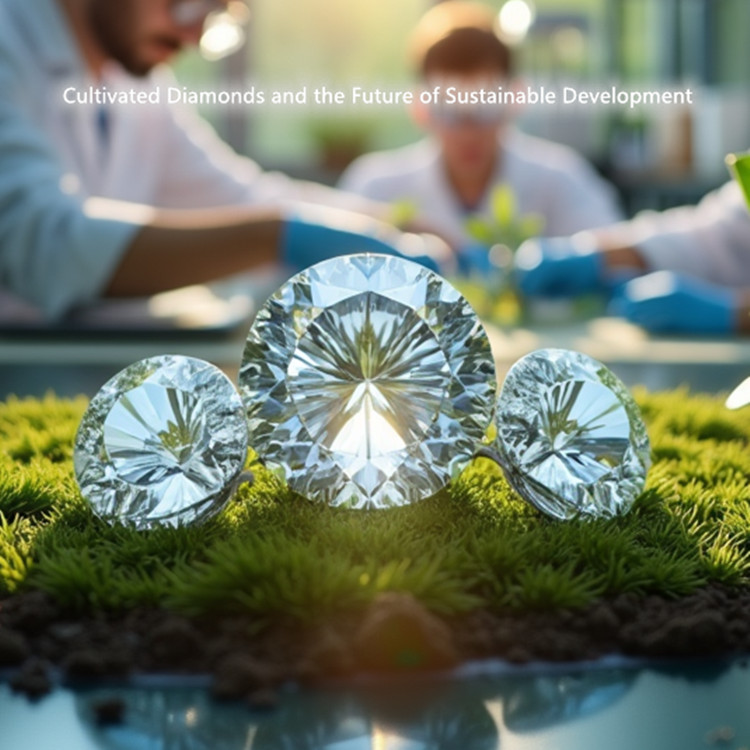
Cultivated Diamonds: Shaping a Sustainable Future for the Jewelry Industry
In recent years, cultivated diamonds have emerged as a compelling alternative to natural diamonds, presenting significant benefits for both the environment and the jewelry industry. This exploration delves into the role of cultivated diamonds in promoting sustainable practices, highlighting their potential to mitigate the ecological damage caused by natural diamond mining, and positioning them as a vital component in the jewelry industry’s eco-conscious movement.
By examining the various aspects of cultivated diamonds, including production methods, environmental impacts, market trends, and consumer behavior, we can gain insight into how these artificial gemstones not only provide a luxury option but also serve as a catalyst for a more sustainable future.
Introduction
The gemstone industry has long been associated with exploitation and environmental degradation. Natural diamond mining, while historically romanticized, often leads to severe consequences for both the environment and local communities. The extraction of diamonds not only disrupts the natural landscape but can also lead to profound social issues, including labor exploitation and conflict financing. As awareness of these issues increases, so too does the demand for sustainable alternatives.
Cultivated diamonds, created through advanced technological processes in controlled environments, present an opportunity to revolutionize the industry. This article will examine the environmental impact of natural diamond mining, the advantages and processes of cultivated diamonds, and their potential to reshape the jewelry industry towards a more sustainable future.
The Environmental Impact of Natural Diamond Mining
Natural diamond mining is a resource-intensive process that involves extensive disturbances to the ecosystem. Understanding its implications requires a closer look at the practices involved and their resultant impacts.
Land Disturbance and Ecosystem Disruption
The extraction process often begins with large-scale land excavation, which significantly affects the local ecosystem. This disruption not only displaces wildlife but also leads to deforestation, as forests are cleared to access diamond deposits. Areas that were once rich in biodiversity face severe habitat loss, leading to diminished populations of many plant and animal species. The longer-term impact of such ecological disruption is often irreversible, with changes in species composition and ecosystem services.
Soil Erosion and Water Pollution
Mining activities contribute to significant soil erosion, degradation of land quality, and disruption of local agricultural practices. The destruction of soil nutrition can result in decreased agricultural yields for communities relying on farming for their livelihood. Furthermore, the process of diamond extraction often involves the use of harmful chemicals, which can leak into nearby waterways, leading to toxic pollution. This contamination adversely affects aquatic ecosystems and leads to health complications for communities reliant on these water sources.
Carbon Footprint of Mining Operations
The carbon footprint associated with natural diamond mining is astonishing. From the diesel-powered machinery used in mining operations to the logistics involved in transporting these stones across the globe, the environmental toll is significant. The transformation of the earth to extract diamonds generates considerable greenhouse gas emissions. Some studies suggest that the carbon emissions tied to traditional diamond mining can reach up to 160 tons per carat, a striking figure that highlights the urgent need for more sustainable practices in the industry.
Cultivated Diamonds: A Sustainable Alternative
Understanding Cultivated Diamonds
Cultivated diamonds, also known as lab-grown or synthetic diamonds, are created using advanced technological processes that mimic the natural conditions under which diamonds form in the Earth. There are primarily two methods for producing these diamonds: High Pressure High Temperature (HPHT) and Chemical Vapor Deposition (CVD).
High Pressure High Temperature (HPHT):
This method replicates the intense heat and pressure conditions that natural diamonds undergo in the Earth’s mantle. A small diamond seed is placed in a chamber along with carbon, and through extreme pressure and heat, a larger diamond is formed around the seed.
Chemical Vapor Deposition (CVD):
This technique involves creating a carbon plasma by heating gases containing carbon, which then deposit carbon atoms onto a diamond seed to form a diamond crystal layer by layer.
Both methods produce diamonds that are chemically and physically identical to natural diamonds but do so without the associated environmental degradation.
Energy Efficiency in Production
In addition to avoiding environmental destruction, the production of cultivated diamonds is often more energy-efficient than traditional mining. The comparative energy requirements are lower, particularly when renewable energy sources are employed in the production process. This not only translates into a smaller carbon footprint but also positions cultivated diamonds as a viable option in the quest for greener luxury goods.
Minimizing Ecological Disruption
One of the most significant benefits of cultivated diamonds is their minimal ecological disruption. Since they are produced in controlled laboratory environments, there is no deforestation, habitat destruction, or soil degradation involved. This aspect aligns perfectly with contemporary values regarding environmental conservation, making cultivated diamonds an attractive option for conscientious consumers.
Transparency and Ethical Considerations
Transparency is an increasingly important factor in consumer decision-making. Historically, the natural diamond supply chain has faced scrutiny due to ethical concerns. Issues such as conflict diamonds—gemstones mined in war zones with profits fueling conflict—have marred the diamond industry’s reputation.
In contrast, cultivated diamonds offer clarity and traceability in their production. Consumers can rest assured they are supporting ethical practices when they choose cultivated diamonds, aligning their purchases with their values of integrity and sustainability.
The Role of Cultivated Diamonds in the Jewelry Industry
Consumer Preference for Sustainable Options
As environmental awareness grows, consumer preferences are shifting. A significant portion of the market is seeking products that reflect their values, and sustainability plays a crucial role in their purchasing decisions.
Research indicates that Millennials and Generation Z consumers are particularly inclined to choose brands that prioritize ethical and environmentally friendly practices. Jewelry brands that embrace cultivated diamonds and incorporate them into their offerings not only attract ethically-minded consumers but also position themselves as industry leaders in sustainability.
Innovative Marketing Strategies
The rise of cultivated diamonds has also spurred innovative marketing strategies within the jewelry industry. Brands are increasingly spotlighting the environmental benefits of their products, framing cultivated diamonds as a part of a commitment to sustainability.
Marketing efforts emphasize the dual narratives of luxury and responsibility, allowing brands to connect with consumers on a deeper level.
For example, jewelers might feature stories about the scientists and artisans involved in creating cultivated diamonds, showcasing the meticulous and innovative processes that yield these beautiful stones. This approach not only adds value to the product but also fosters a sense of connection between the consumer and the makers.
Partnerships and Collaborations
Jewelry brands can further amplify their sustainability message by forming partnerships with organizations focused on environmental sustainability. Collaborating on initiatives aimed at preserving natural habitats or supporting communities impacted by historic mining practices can enhance brand reputation and demonstrate a commitment to a more sustainable future.
Such collaborations can lead to joint marketing campaigns, educational efforts, and community engagement projects that resonate with increasingly eco-conscious consumers.
The Future of Cultivated Diamonds
Market Growth Potential
The market potential for cultivated diamonds shows no signs of slowing down. As the technology behind diamond cultivation continues to evolve, the quality and accessibility of these stones will likely improve, leading to a broader acceptance within the luxury segment. Growth estimates for the lab-grown diamond market predict significant increases in both production and sales, indicating that these diamonds are not merely a passing trend but rather a new standard for the jewelry industry.
Consumer Education and Awareness
For cultivated diamonds to gain widespread acceptance, continued consumer education and awareness efforts are essential. Future marketing campaigns should focus not only on the aesthetic and financial benefits of cultivated diamonds but also on their positive environmental impact.
By enhancing knowledge about the ecological footprint of natural diamonds versus cultivated alternatives, consumers may be empowered to make informed choices. Educational initiatives can extend beyond marketing, including collaborations with schools, universities, and environmental organizations to raise awareness about sustainable practices in consumer behavior.
Conclusion
Lab diamonds present a promising solution to the environmental challenges posed by traditional diamond mining. Their reduced ecological footprint, ethical production practices, and alignment with evolving consumer values make them a critical component in the transformation of the jewelry industry towards sustainability. As awareness and demand for cultivated diamonds continue to rise, they can redefine luxury, enabling consumers to embrace elegance without compromising their values.
Through collective efforts in education, innovative marketing, and transparent practices, the jewelry industry can elevate cultivated diamonds as symbols of a brighter, more sustainable future. In doing so, we not only celebrate the beauty of these gemstones but also acknowledge our responsibility to protect the planet for future generations.










